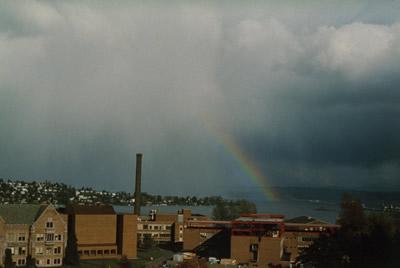Weather map showing an occluded front
Click on image for full size
Windows to the Universe image by Lisa Gardiner
Occluded Fronts
Sometimes a cold front follows right behind a warm front. Because cold fronts move faster, the cold front can run into the warm front. This is called an occluded front.
At an occluded front, the cold air from the cold front meets the cool air that was in front of the warm front. The warm air rises. Occluded fronts usually form around low pressure areas.
There is often rain or snow along the front from cumulonimbus or nimbostratus clouds. Wind changes direction as the front passes and the temperature changes too. After the front passes, the sky is usually clearer.
On a weather map, like the one on the left, an occluded front looks like a purple line with half triangles and half semicircles pointing in the direction that the front is moving. At one end there is a low pressure area (the ‘L’). At the other end, the occluded front connects to cold and warm fronts.
Last modified August 12, 2009 by Lisa Gardiner.
You might also be interested in:

Cumulonimbus clouds belong to the Clouds with Vertical Growth group. They are also known as thunderstorm clouds. A cumulonimbus cloud can grow up to 10km high. At this height, high winds make the top
...more
Nimbostratus clouds are part of the Low Cloud group. They are dark gray with a ragged base. Nimbostratus clouds produce rain or snow. Sometimes they cover the whole sky and you can't see the edges of
...more
Wind is moving air. Warm air rises, and cool air comes in to take its place. This movement creates the winds around the globe. Winds move at different speeds and have different names based on their speed.
...more
Weather fronts can cause clouds, rain, thunderstorms, gusty winds, and even tornadoes. Usually the skies clear once the front has passed. Weather fronts happen because not all air is the same. In some
...more
There are two main types of thunderstorms: ordinary and severe. Ordinary thunderstorms are the common summer storm. Ordinary thunderstorms last about one hour. Rain and small hail occur. Severe thunderstorms
...more
A supercell thunderstorm is a huge rotating thunderstorm. It can last for several hours. These storms are likely to form long lasting tornadoes and large hail. There are two types of supercell thunderstorms.
...more
Lightning is the coolest thing about a thunderstorm. In fact, it is how thunderstorms got their name. Wait a minute, what does thunder have to do with lightning? Well, lightning causes thunder. Lightning
...more















